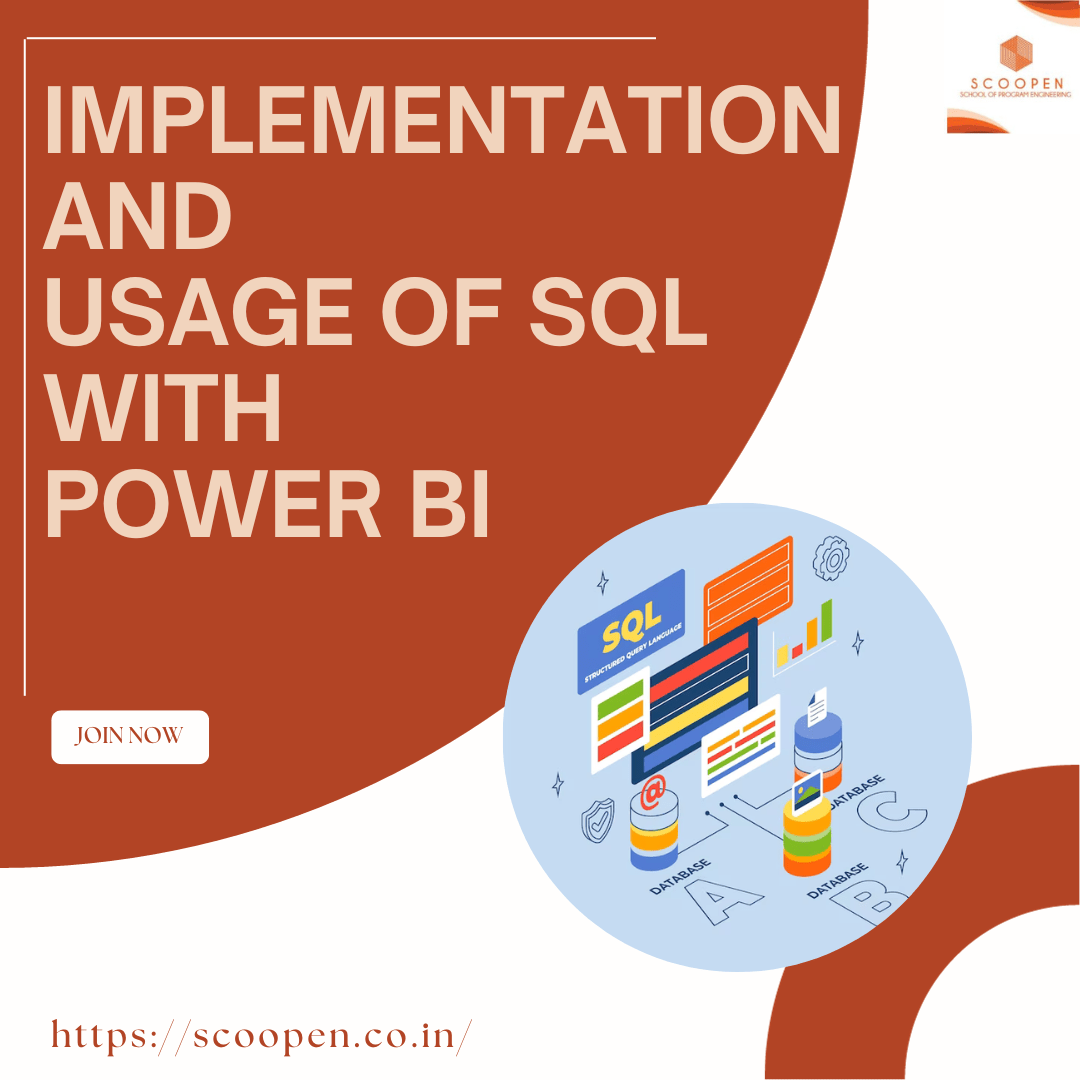Power BI is a cloud-based business analytics service from Microsoft enabling you to visualize and analyze data, endowed with better speed, understanding and efficiency. It’s a powerful and flexible tool for connecting with and analyzing a wide array of data. Furthermore, Power BI has to its credits an astounding out-of-the-box connection capabilities like easily integrating with Databases thereby enhancing the advantages/benefits pertaining to functionalities, which comes in handy for Data Scientists accustomed to working in SQL. It has the ability of providing an optimized, live connector to SQL server-know-hows of which are taught in SQL Power BI course, so that we can easily create charts, reports and dashboards via directly working with a huge amount of data.
One can use SQL with Power BI imparted in the SQL Power BI course to connect to and query data from varied data sources. Power BI supports both importing data into its own data model and creating Direct Query or Live Connection connections to external data sources employing SQL queries.
Below are pointers to how you can use SQL with Power BI:
- Import Data-Power BI enables you to import data from varied sources like databases, Excel files, CSV files and more. When importing data, Power Query Editor allows you to transform and shape the data employing a graphical interface or custom SQL queries thereby enabling you to create more efficient and accurate reports.
To use SQL for data transformation, choose ‘Advanced Editor’ option in Power Query Editor and write SQL queries for manipulating and transforming data prior to loading it into Power BI’s data model. Furthermore, use Power BI Advanced Editor to write more complex SQL queries. The Advanced Editor provides a variety of features making it easier to write and edit SQL queries.
- Direct Query-Power BI supports Direct Query, enabling you to connect to external databases or data sources using SQL without importing data into Power BI. This way, your reports and dashboards can directly query the source data in real-time.
When using DirectQuery, you create a data source connection employing SQL, and your visuals in Power BI send SQL queries to the data source for retrieving data upon viewing the report.
- Live Connection-Similar on the lines of DirectQuery, Power BI allows you to establish a Live Connection to data sources like SQL Server Analysis Services (SSAS) or other external data sources using SQL learnt in SQL Power BI course. In this case, you create a connection to the data source, with data remaining the same in the source system.
You can use DAX (Data Analysis Expressions) for creating calculations and measures when working with Live Connection.
To make the most of SQL with Power BI taught in the SQL Power BI course, one should have a thorough understanding of SQL queries and database connections. Moreover, one requires to provide necessary connection details like server name, database name, credentials, upon setting up the data source in Power BI. However, always keep in mind that specific capabilities and features tend to vary in keeping with the version of Power BI that one’s using. So, it’s imperative to refer to official Power BI documentation, resources for extensive and detailed instructions, and instances based on your specific version.
A Comprehensive & Step-By-Step Guide to Use SQL with Power BI taught in SQL Power BI Course
Connecting to SQL database in Power BI Desktop, follow these steps:
- On the Home Tab, select Get data>SQL Server.
- In the SQL Server database dialog box, enter server & database names.
- Select OK.
- If prompted, enter credentials.
Using Power Query Editor:
Upon connecting to SQL database, use Power Query Editor for shaping and transforming data. To open Power Query Editor, select the table you want to transform and click Edit Queries.
In Power Query Editor, one can perform number of tasks like:
- Removing columns
- Filtering rows
- Changing data types
- Merging tables
- Splitting columns
Writing SQL queries in Power BI learnt in SQL Power BI course:
One can also write his/her own SQL queries directly in Power BI. To do this, one needs to follow these steps:
- On Home Tab, select Get data>Blank Query.
- In the Blank Query dialog box, select Enter Data Source Name.
- In the Data Source Name dialog box, enter the name of SQL server & database.
- Select OK.
- In the Query Editor, enter your SQL query.
- Click Run to execute the query.
Using SQL to create reports in Power BI:
Once you’ve shaped and transformed data, you can use it for creating reports in Power BI. To do this, drag and drop fields from Fields pane onto the canvas.
Moreover, you can use SQL for creating dynamic reports. For instance, you could create a report showing top 10 sales for each month. To do this, use SQL query for filtering data by month and then select top 10 rows.
However, it’s advisable to use parameters in SQL queries for making dynamic reports. Parameters enable you to change values in your query without having to rewrite the query.
Goes without saying, SQL is a powerful tool used for shaping, transforming, and analysing data in Power BI. By making the most of SQL, you can create reports that are tailored to your specific requirements.
Specific instances of using SQL in Power BI taught in SQL Power BI course:
- Filter data-One can use SQL for filtering data based on specified requirements/criteria. For instance, one could filter data for showing only sales for specific products or customers.
- Aggregate data-You can use SQL for aggregating data into groups. For example, you could group sales by product category or region.
- Calculate new columns-You can use SQL to calculate new columns based on existing data. For instance, you could calculate a new column showing up the profit margin for each sale.
- Join tables-One can use SQL for joining tables from varied data sources. For example, one can join a table of sales data with a table of customer data for creating a single table showing up all of the sales for each customer.
- Create subqueries-You can use SQL to create subqueries, which are queries embedded within other queries. Subqueries can be used for performing complex calculations or filtering data.
Specific examples of using SQL for improving Power BI Reports:
- Filter data to focus on what’s important-SQL enables you to filter data based on your desirable criteria. For instance, you could filter data for showing up sales only for specific product category, region, or customer segment thereby helping you to focus on data that’s most important to you and your audience.
- Aggregate data to identify trends-SQL allows you to aggregate data into groups, which aids you in identifying trends and patterns in data. For example, you could group sales by month or quarter to see how sales have changed over time.
- Calculate new columns to gain insights-SQL enables you to calculate new columns based on existing data. For instance, you could calculate a new column showing profit margin for each sale. This’ll help you to gain new, valuable insights into data, identifying areas where you can improve profitability.
- Join tables to get a complete picture-SQL allows you to join tables from various data sources, beneficial for getting a complete picture of data. For instance, you could join a table of sales with a table of customer data for creating a single table showing all of sales for each customer.
- Create subqueries to perform complex calculations or filter data-SQL enables you to create subqueries, which are queries embedded within other queries. For example, you could use a subquery for filtering data to only show sales that were made to customers who’ve placed more than a certain number of orders.
Furthermore, SQL is indispensable for Power BI imparted in SQL Power BI course as it’s a standard language supported by a host of databases, enabling SQL skills to connect to and analyse data from numerous sources including relational databases, cloud databases, and NoSQL databases.
Learn SQL Power BI course at Scoopen School of Program Engineering located at Dhankawadi, Pune India offering courses in SQL PLSQL, Power BI, SAP SD MM HANA, Python Data Science, Database, AWS Azure, DevOps, Business Analyst, Micro.Net, Angular JS, Java Course, Soft Testing, providing the biggest competitive Cloud, Analytics, and Automation platform in Pune. Established in 2011, Scoopen School of Program Engineering is the top player in the category of Computer Training institutes, equipped with best-in-class professional, experienced mentors possessing sound technical knowledge in structures & project management, teaching easy-to-understand style of presentation. In fact, Scoopen School of Program Engineering has received Excellence Award Winner in Year 2016, 2017 & 2018 consecutively in Multiple technologies by PROGVALTON TECH for astounding proficiency and excellence thereby setting the benchmark for posterity!


